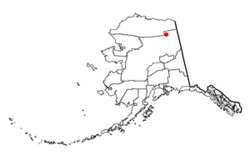Arctic Village, Alaska
Arctic Village, Alaska | |
|---|---|
 Location of Arctic Village, Alaska | |
| Country | United States |
| State | Alaska |
| Census Area | Yukon-Koyukuk |
| Area | |
| • Total | 69.8 sq mi (180.9 km2) |
| • Land | 61.7 sq mi (159.8 km2) |
| • Water | 8.1 sq mi (21 km2) |
| Population (2000) | |
| • Total | 152 |
| Time zone | UTC-9 (Alaska (AKST)) |
| • Summer (DST) | UTC-8 (AKDT) |
| Area code | 907 |
| FIPS code | 02-03990 |
Arctic Village is an unincorporated Native American village[1] and a census-designated place (CDP) in Yukon-Koyukuk Census Area, Alaska, United States. As of the 2000 census, the population of the CDP was 152. The village is located in the large Gwitch'in speaking region of Alaska, and the local dialect is known as Di'haii Gwitch'in or Kutchin.[citation needed] As of 1999, over 95% of the community speaks and understands the language. (Kraus, 1999)[full citation needed]
Geography
Arctic Village is located at 68°7′19″N 145°31′40″W / 68.12194°N 145.52778°W (68.121828, -145.527686)Template:GR, on the east fork of the Chandalar River, about a hundred miles north of Fort Yukon.[2] The area consists of flat floodlands near the river, but is mostly wooded hills.[2]
Both the CDP and the "village" have the same total area, 69.9 square miles (180.9 km²), of which, 61.71 square miles (159.8 km²) is land and 8.12 square miles (21.0 km²) (11.63%) is water.[2][3]
History
Evidence from archaeological investigations indicate that the Arctic Village area may have been settled as early as 4500 BC.[2] Around 500 AD the Athabascan speaking Gwich’in people (often called Neets'aii Gwich'in or “those who dwell to the north”)[2] came into the area with seasonal hunting and fishing camps. About 1900, the village became a permanent settlement.[2]
Demographics

As of the censusTemplate:GR of 2000, there were 152 people, 52 households, and 30 families residing in the CDP. The population density was 2.5 people per square mile (1.0/km²). There were 67 housing units at an average density of 1.1/sq mi (0.4/km²). The racial makeup of the CDP was 7.89% White, 86.18% Native American, and 5.92% from two or more races. 0.66% of the population were Hispanic or Latino of any race.
There were 52 households out of which 44.2% had children under the age of 18 living with them, 25.0% were married couples living together, 21.2% had a female householder with no husband present, and 40.4% were non-families. 32.7% of all households were made up of individuals and 3.8% had someone living alone who was 65 years of age or older. The average household size was 2.92 and the average family size was 3.58.
In the CDP the population was spread out with 41.4% under the age of 18, 9.9% from 18 to 24, 28.9% from 25 to 44, 17.8% from 45 to 64, and 2.0% who were 65 years of age or older. The median age was 24 years. For every 100 females there were 114.1 males. For every 100 females age 18 and over, there were 128.2 males.
The median income for a household in the CDP was $20,250, and the median income for a family was $19,000. Males had a median income of $21,875 versus $10,000 for females. The per capita income for the CDP was $10,761. About 30.8% of families and 46.3% of the population were below the poverty line, including 53.1% of those under the age of eighteen and none of those sixty five or over.
Arctic Village in popular culture
Literature
- J. C. Hutchins' 7th Son, Book 2, Deceit features Arctic Village as a location containing a clue concerning the antagonist's plans.
References
- ^ Arctic Village is recognized by the Bureau of Indian Affairs as an unincorporated Native Village under the Indian Reorganization Act of 1934. See, Indian Affairs Bureau, Department of the Interior (2005) "Alaska Region: A: Native Village of Arctic Village" Federal Register 21 March 2005, Volume 70, Number 53, p. 13519
- ^ a b c d e f Tiller, Veronica E. Velarde (2005) "Venetie" Tiller's Guide to Indian Country BowArrow Publishing Co., Albuquerque, NM, p. 278, ISBN 978-1-885931-04-7
- ^ "Census 2000 U.S. Gazetteer File: Places", United States Census Bureau

